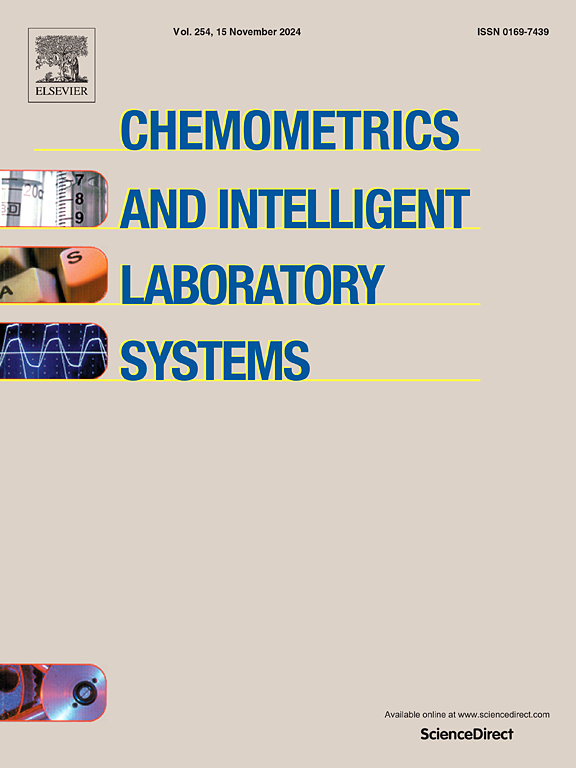Enhancing one-class classification performance through variable selection: A review based on advanced literature search approaches
IF 3.8
2区 化学
Q2 AUTOMATION & CONTROL SYSTEMS
Chemometrics and Intelligent Laboratory Systems
Pub Date : 2025-07-21
DOI:10.1016/j.chemolab.2025.105491
引用次数: 0
Abstract
Variable selection is a key step in improving One-Class Classification (OCC), especially when applied to high-dimensional datasets common in chemometrics and anomaly detection tasks. This systematic literature review explores how different strategies—filter, wrapper, embedded, and hybrid methods—have been employed to enhance OCC models' accuracy, interpretability, and robustness. A comprehensive search was conducted using Scopus, complemented by AI-powered tools such as Elicit and Litmaps, and visual analytics platforms including VOSviewer and Bibliometrix. The review highlights methodological trends across both chemometric and machine learning domains, revealing a predominance of embedded approaches and a growing interest in hybrid strategies. Embedded methods, particularly LASSO, Elastic Net, and autoencoder-based architectures, were favored for their scalability and model integration. Approximately 69 % of the reviewed studies adopted a rigorous OCC approach—relying solely on target class data—demonstrating a preference for bias-resistant modeling. Additionally, bibliometric analysis revealed a disciplinary division, with chemometric studies emphasizing analytical applications and model interpretability, while computer science-driven studies prioritized automation and scalability. The findings emphasize the need for flexible, domain-adapted variable selection pipelines capable of handling class imbalance and high dimensionality. This work also introduces a reproducible framework combining traditional and AI-assisted literature review tools to support future systematic analyses. The review concludes by identifying emerging trends and suggesting future research directions in OCC and variable selection, with a focus on hybrid modeling, domain adaptability, and performance benchmarking across application fields.

通过变量选择提高一类分类性能:基于先进文献检索方法的综述
变量选择是改进单类分类(OCC)的关键步骤,特别是当应用于化学计量学和异常检测任务中常见的高维数据集时。这篇系统的文献综述探讨了不同的策略——过滤、包装、嵌入和混合方法——如何被用来提高OCC模型的准确性、可解释性和鲁棒性。使用Scopus进行了全面的搜索,辅以人工智能工具(如Elicit和Litmaps)以及视觉分析平台(包括VOSviewer和Bibliometrix)。这篇综述强调了化学计量学和机器学习领域的方法趋势,揭示了嵌入式方法的优势和对混合策略日益增长的兴趣。嵌入式方法,特别是LASSO、Elastic Net和基于自动编码器的体系结构,因其可伸缩性和模型集成而受到青睐。大约69%的研究采用了严格的OCC方法——完全依赖目标类数据——这表明了对抗偏倚建模的偏好。此外,文献计量学分析揭示了学科划分,化学计量学研究强调分析应用和模型可解释性,而计算机科学驱动的研究优先考虑自动化和可扩展性。研究结果强调需要灵活的、领域适应的变量选择管道,能够处理类不平衡和高维。这项工作还介绍了一个可重复的框架,结合了传统和人工智能辅助的文献综述工具,以支持未来的系统分析。本文最后指出了OCC和变量选择的新兴趋势,并提出了未来的研究方向,重点是混合建模、领域适应性和跨应用领域的性能基准测试。
本文章由计算机程序翻译,如有差异,请以英文原文为准。
求助全文
约1分钟内获得全文
求助全文
来源期刊
CiteScore
7.50
自引率
7.70%
发文量
169
审稿时长
3.4 months
期刊介绍:
Chemometrics and Intelligent Laboratory Systems publishes original research papers, short communications, reviews, tutorials and Original Software Publications reporting on development of novel statistical, mathematical, or computer techniques in Chemistry and related disciplines.
Chemometrics is the chemical discipline that uses mathematical and statistical methods to design or select optimal procedures and experiments, and to provide maximum chemical information by analysing chemical data.
The journal deals with the following topics:
1) Development of new statistical, mathematical and chemometrical methods for Chemistry and related fields (Environmental Chemistry, Biochemistry, Toxicology, System Biology, -Omics, etc.)
2) Novel applications of chemometrics to all branches of Chemistry and related fields (typical domains of interest are: process data analysis, experimental design, data mining, signal processing, supervised modelling, decision making, robust statistics, mixture analysis, multivariate calibration etc.) Routine applications of established chemometrical techniques will not be considered.
3) Development of new software that provides novel tools or truly advances the use of chemometrical methods.
4) Well characterized data sets to test performance for the new methods and software.
The journal complies with International Committee of Medical Journal Editors'' Uniform requirements for manuscripts.

 求助内容:
求助内容: 应助结果提醒方式:
应助结果提醒方式:


